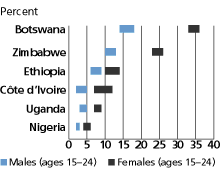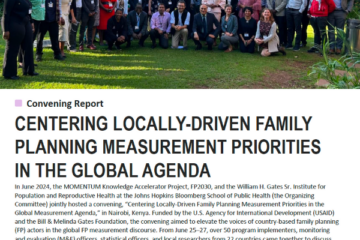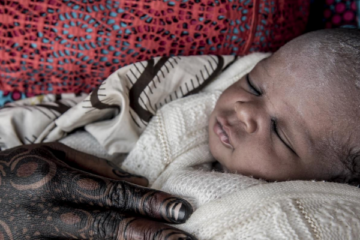
Young Women in Sub-Saharan Africa Face a High Risk of HIV Infection
(March 2002) New data released on World AIDS Day in December revealed a growing but under-reported tragedy: In sub-Saharan Africa, the epidemic’s victims are increasingly young and female. The latest global estimates, prepared by the Joint United Nations Programme on AIDS (UNAIDS), show that in sub-Saharan Africa, the region hardest hit by the epidemic, about 8.6 million people between the ages of 15 and 24 are living with HIV or AIDS. Of these, 5.7 million are young women (see table).
Young People Living With HIV/AIDS
| Number of people ages 15 to 24 | ||
|---|---|---|
| Young Women | Young Men | |
| Sub-Saharan Africa | 5,700,000 | 2,800,000 |
| World Total | 7,300,000 | 4,500,000 |
Source: UNAIDS, unpublished estimates, December 2001, as cited in K. Kiragu, “Youth and HIV/AIDS,” Population Reports (Fall 2001).
These numbers stand in striking contrast to global data on the AIDS epidemic. Worldwide, women account for an estimated 48 percent of adults ages 15 to 49 who are living with HIV or AIDS. In sub-Saharan Africa, where HIV is spread mainly through heterosexual activity, women account for 55 percent of infected adults. Among those ages 15 to 24, however, young women account for 66 percent of those infected. (The figure below shows the disparity in percentages of young people infected, by gender.)
HIV Prevalence Among African Youth

Estimated percentage ranges in selected countries, end 1999
Source: UNAIDS, Report on the Global HIV/AIDS Epidemic (June 2000).
Studies have shown that adolescent girls in this region are between two and six times more likely to contract HIV than their male peers. These girls and women face a whole range of disadvantages that make them especially vulnerable to infection.
- Biological factors. Physiological differences between men and women make transmission of HIV through sexual contact more efficient from men to women than vice versa. (During sexual intercourse, a woman has a larger surface area of her genital tract exposed to her partner’s sexual secretions than a man does.) The immature reproductive tracts of adolescent girls make them even more susceptible to infection than adult women.
- Social dynamics. Commonly paired with older partners who have already been exposed to HIV, girls and young women often lack the knowledge or self-confidence to resist sexual advances or persuade older men to use condoms. Girls are also more likely than boys to be raped or coerced into sex by someone older and more powerful.
- Cultural practices. In many societies, parents teach young women to be submissive to men and arrange marriages for their daughters at young ages. In these situations, and when men have multiple wives, newly married young women may contract HIV unknowingly from their sexually experienced husbands. Many women do not bring up the subject of HIV status with their husbands for fear of violence or reprisals. Also, some societies practice wife inheritance, a tradition in which a wife is given to her brother-in-law upon her husband’s death. This can expose either partner, if he or she was not already exposed, to HIV infection.
- Economic deprivation. Poverty may compel girls and women to offer sex in exchange for money or gifts. And the most impoverished women are the least likely to seek out or have access to services for the prevention or treatment of sexually transmitted infections, including HIV/AIDS.
A Johns Hopkins University report on youth and AIDS published in December 2001 warns that, as the AIDS epidemic spreads, infection will continue to spread to younger age groups as men choose increasingly younger sexual partners. “Many men believe, probably correctly, that younger girls are less likely to be infected with HIV,” the authors explain, “while others hold the mistaken belief that having sex with a virgin can cure AIDS.”
Reflecting these trends in sexual preferences, young women with HIV are infected on average 10 years earlier than men and, consequently, many will die at younger ages than men. As a result of this situation, the U.S. Census Bureau projects that by 2020 there will be more men of reproductive age than women in the most severely affected countries of sub-Saharan Africa. This imbalance could lead men to seek even younger women, further increasing HIV infection among adolescent females.
In spite of their exceptional vulnerability, millions of young African women are ignorant about HIV/AIDS and how to prevent it. Demographic and Health Surveys from the region show that, among young women, knowledge of at least one preventive measure (such as abstaining from sex or using a condom) ranges from 15 percent in Mozambique to 72 percent in Kenya. In all countries surveyed, young women have lower awareness than their male peers.
Experiences in Uganda and Senegal provide some hope that the epidemic can be brought under control, given adequate commitment. In these countries, governments confronted the epidemic early, with donor support, and launched nationwide information and education campaigns that reached down to the village level, including schools. Unfortunately, this kind of commitment is lacking in most parts of the continent.
AIDS education among young people and promotion of condom use are controversial undertakings nearly everywhere. But many programs have demonstrated effective ways to promote responsible sexual behavior through peer educators and other innovative channels. In particular, health experts are advocating prevention efforts that take into account the distinct social roles and circumstances of men and women. For example, programs can provide information and counseling to young women to help them gain negotiating skills, and to young men to help them resist the social pressures that lead to risky behaviors.
The new figures represent only rough estimates, based on country data that are not yet refined. Nevertheless, they should serve as a wake-up call to policymakers that, to bring the AIDS epidemic under control, much greater focus on young people is needed.
Lori Ashford is a senior policy analyst at PRB.
For More Information
Kiragu, Karungari. “Youth and HIV/AIDS: Can We Avoid Catastrophe?” Population Reports, Series L, No. 12. Baltimore: The Johns Hopkins University Bloomberg School of Public Health, Population Information Program, 2001.
Sass, Justine, and Lori Ashford. Women of Our World 2002. Washington, DC: Population Reference Bureau, forthcoming February 2002.
Joint United Nations Programme on AIDS. AIDS Epidemic Update December 2001. Geneva: UNAIDS, December 2001.






